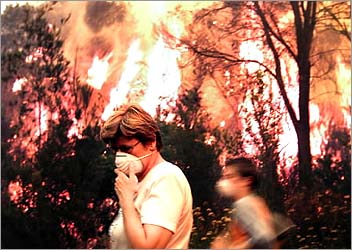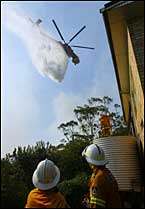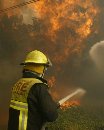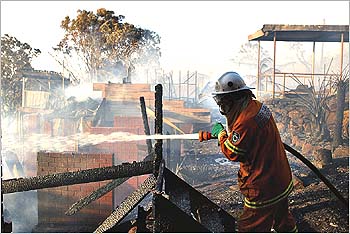
- Elvis returns to fire duties in NSW, Vic
(ABC News Online, October 15, 2003)
A US-based firefighting helicopter dubbed Elvis will return to Australia this bushfire season after its successful use in last year. Two of the huge helicopters will shared between New South Wales and Victoria as part of an aircraft strategy to assist with firefighting. The New South Wales Minister for Emergency Services Tony Kelly says the helicopters will be joined by two smaller water bombers. Mr Kelly says although the Government looked at buying its own helicopter, it was not financially viable. "It would mean that they would be sitting on the ground for perhaps eight or nine months of the year when their not used," he said. "By hiring for the few months that we need them, they're able to be used somewhere else in the world and obviously therefore we pay a much reduced cost."
- More helitankers to join battle
By Andra Jackson
([Melbourne] Age, January 25, 2003)
Two more "Elvis-style" water-carrying helitankers will be leased from the United States and brought to Victoria to help fight bushfires. Announcing the $2.1 million Federal contribution yesterday, Prime Minister John Howard said the bushfire crisis facing Victoria was "far from over".
Premier Steve Bracks said the state faced its worse fire threat since the 1930s. He warned the present fires might not go out for several weeks. Mr Howard also warned: "All Australians should understand that the coming weekend in different parts of our country could see a level of bushfire threat, the equal of what we've had over the past few weeks and perhaps even worse."
- Qld big dry keeps firefighters on alert
(ninemsn.com.au, January 24, 2003)
Firefighters will monitor two bushfires in south-east Queensland over the long weekend and remain on alert for more blazes as the state faces unseasonal dry conditions. Firefighters worked through the night to establish containment lines to halt a bushfire near Goodwood, south of Bundaberg, which threatened property on Thursday. A Queensland Fire and Rescue Service spokeswoman said the blaze, which started in inaccessible land, was under control and there was no current threat to property.
Goodwood Rd between Foley's and Woodgate Roads, about 30km south of Bundaberg, was reopened about noon (AEST) after being closed for much of the night and morning. Meanwhile, a fire which has been burning on North Stradbroke Island, east of Brisbane, for almost a fortnight was still ablaze. Smoke from the fire, which has not threatened property, can be seen and smelled throughout Brisbane's south and the Gold Coast.
A Queensland Ambulance Service spokesman has warned asthmatics and people with respiratory conditions to take extra care. "If previous smoke haze is anything to go by there can be a high increase in respiratory problems," the spokesman said. ...
Already plans have been made to import two more Elvis-style firefighting helicopters within a week.
- Fears Vic fires could move south
(ninemsn.com.au, January 24, 2003)
Fire authorities fear the bushfires raging across north-eastern Victoria for the past fortnight could spread this weekend to create the state's worst bushfire crisis in more than 60 years. Residents in the Gippsland to the south of the fronts have been warned to prepare for fires over the Australia Day long weekend which is expected to be hot, dry and windy - the worst possible conditions for bushfires.
A total fireban across Victoria has been declared for Saturday. Premier Steve Bracks said the threat this weekend would peak on Sunday. ... Prime Minister John Howard, in Melbourne to announce that Australia would lease two additional "Elvis-like" helitankers from the US for the bushfire season, was briefed on the situation this afternoon.
- Water-bombing aircraft needed
[Letter to the editor]
From Romuald S. Baczynski
(Canberra Times, January 24, 2003, p.22)
... I seem to recall that after the 2001 Christmas fires in the ACT, Victoria and NSW, our political leaders were outdoing each other lauding the American firefighting helicopters like "Elvis", promising to purchase or hire as many as necessary. ... If our emergency services had at their ready disposal half a dozen or so "Elvises", or a couple of Antonov water-tanker aircraft, then the Namadgi Park bushfire would have never developed into the raging monster that confronted Canberra. ...
- ACT Bushfire disaster: the incredible saviour from the skies
By Scott Hannaford
(Canberra Times, January 24, 2003, p. 5)
When the Incredible Hulk opened its tanks and let loose its cargo of 9500 litres of water over Hall yesterday, the small community knew the big guns had been called in to try to save their village. ... The two aircranes brought out by NSW authorities, Georgia Peach and The Incredible Hulk, have been in constant use in the Canberra region, while a third aircrane [Elvis] has been sent to Victoria to tackle the bushfires there.
... Elvis, contracted by Victorian Department of Natural Resources and Environment for use in Victoria.
- Elvis the chopper joins firefighters
By Andrew Heasley
(Melbourne Age, January 23, 2003)
The small country town of Stanley, nine kilometres south-east of Beechworth, was choked in smoke from bushfires still burning last night on three sides of the district.
The town's population of 500 had rallied earlier in the day to confront the fires on the front line with CFA firefighters The authorities warned that the community still needed to be alert to changing conditions. Lee Whamond, a Stanley resident of 12 years, said she had first smelt smoke at noon on Tuesday. "I was at home and could smell the fires quite distinctly, and I looked over towards Mount Buffalo and the sky was red," she said. The first fire began in an area of bush and tall timber at Buckland Gap, to the south-east of the township. Fanned by a swirling south-westerly wind, the fire made rapid progress towards the town. ... The fire advanced on the town, coming within 100 metres of some homes. Elvis, the water-bombing helicopter, was summoned for duty, scooping water from Lake Sambell in Beechworth and dumping it on the firefront. "It did a lot work to save houses," Mr Sinclair said. "It saved the day."
But there was no rest for the town. Second and third fires to the east and north blanketed Stanley in smoke. The Stanley area fire was covering about 3300 hectares with significant spotting into the communities of Chiltern, Indigo Valley, Yackandandah, Allan's Flat and Osborne's Flat. A fire in nearby Eldorado and Beechworth was covering about 7000 hectares. Police, the CFA and the Department of Sustainability and Environment are investigating the causes of both fires. Lighter winds yesterday helped to slow their progress. However, residents as far away as Wodonga and Myrtleford experienced heavy smoke, causing some concern. There are 500 firefighters, 97 tankers, nine bulldozers and two graders battling the fires.
- No sweat, it's fighting fires from a distance
By Melissa Fyfe
(Melbourne Age, January 15, 2003)
In the fire-fighting business, this is the clean work. Little sweat and no black stuff - unless you count the coffee. The nerve centre of the state's fire-fighting effort is in an office block on Victoria Parade [Melbourne]. Here, the Department of Sustainability and Environment keeps a 24-hour vigil on the seven million hectares under its care. The national park, state forest and protected public land makes up roughly a third of the state. ... From the emergency centre DSE can dispatch one of the star fire-fighters - the water-carrying helicopter Elvis, or HTK141, as it is correctly called. But Elvis was used sparingly, Dr Matthews said. Elvis is not cheap. It uses 2000 litres of fuel an hour and comes with a team of 10 people and a 40,000-litre fuel tanker. Decisions had to be made about the most efficient use of resources, Dr Matthews said.
- Elvis returns for a welcome encore performance
(Canberra Times, December 9, 2002)
After a successful campaign a year ago, Elvis is due back in Sydney today for an encore performance. The giant helitanker, credited with saving hundreds of homes during last year's Christmas bushfire crisis, will arrive at Bankstown Airport to complement the nearly 100 aircraft alrady in use around NSW. The state Government and Rural Fire Service Commissioner Phil Koperberg have cautioned that the aircranes are just one aspect of the firefight effort. But for families living in bushfire-prone areas, the arrival of Elvis and its 9000-litre water-dumping capability will be a welcome sight. Elvis will join helitankers Georgia Peach and The Incredible Hulk in the main bushfire hot spots.
The Rural Fire Service said it expected the helitanker to be operational by Wednesday at the latest after being assembled and tested at Bankstown Airport. Each helitanker costs [A]$12,000 an hour to operate and millions to lease but the Federal Government is footing half the leasing bill. ... "We have more aircraft at our service right now than the Australian Air Force", RFS spokesman Ross West said. Among the fleet is the new k-max chopper, which had been used to fight fires during the North American summer. "Unfortunately, because everyone knows Elvis they don't take a look at this one, but it has been used much more effectively inside the United States", Mr West said.

- Hope rises above the tallest flames
By Brigid Delaney and Stephanie Peatling
(Sydney Morning Herald, December 9, 2002)
After his dire predictions that the state would "burn until there's nothing left", a cautiously upbeat Fire Commissioner Phil Koperberg yesterday said the worst could soon be over. "These particular fires are approaching an end," he said. "It's 36 hours away." The weather bureau predicts a southerly wind will move through Sydney this morning bringing with it low temperatures and increased humidity. It is confident of showers in all the areas affected by fires by Tuesday. ... But the weather was a foe, not a friend, yesterday afternoon. Strong winds of up to 50kmh caused havoc in the Blue Mountains, while a wind change in the Shoalhaven increased the strength of the long-running Touga fire. That fire was well away from homes but it kept consuming bushland, with 100,000 hectares devastated so far. ... The fires will cost NSW taxpayers more than $100 million, the Premier, Bob Carr, estimated. Much of the expense is due to the high cost of running water-bombing equipment. Three giant helitankers from the United States - including Elvis, arriving today - cost $12,000 an hour to operate and millions to lease.

- Elvis to help fight Sydney fires
By Margaret Simons
(nzoom.com, December 8, 2002)
A third giant helitanker is due to join the battle against New South Wales bush fires on Monday. Elvis, the helitanker credited with saving hundreds of homes during last year's Christmas bushfires is due back in Sydney on Monday to join Georgia Peach and The Incredible Hulk in the main bushfire hotspots. Meanwhile, 4,000 Australian firefighters were taking advantage of easing weather conditions on Monday to try to bring the bushfires raging across New South Wales under control. The Rural Fire Service (RFS) said that crews had been able to complete some much-needed backburning work and containment lines kept some blazes under control. Some areas causing concern: The RFS said that fires in the Blue Mountainsaround Blackheath and Wentworth Falls and blazes north of Sydney at Berowra Waters and Brooklyn were causing the most concern.

- Move over Big Elvis - it's the lightweight K-Max
By Margaret Simons
(Sydney Morning Herald, December 7, 2002)
They're calling it the egg-beater. And although firefighters are a bit cynical about celebrity helicopters after the attention given to the "Elvis" helitanker, air operations officers were yesterday admitting they were impressed with the latest addition to their arsenal. The egg beater, more properly called the K-Max, is a lightweight helicopter from the United States that has been used to fight fires in America for some years. But it made its Australian debut in the Blue Mountains this week. There is only one in the country, on lease to the Rural Fire Service. The K-Max is designed to carry only a pilot, with its light weight making it unusually nimble. Yet the K-Max can lift more than its own weight in water - more than a conventional helicopter.

- Sydney Firefighters Battle House to House
By Michael Perry
(Yahoo! News / Reuters, December 6, 2002)
Firefighters fought flames from house to house in northwestern Sydney Friday as gale-force winds whipped up fierce bush fires threatening scores of homes in Australia's main city. ... (as below with editing)
 
- Sydney Fights Infernos House to House
By Michael Perry
(Yahoo! News / Reuters, December 6, 2002)
Engulfed in choking, blinding smoke, firefighters fought flames house to house in northern Sydney Friday as gale-force winds whipped up fierce bush fires threatening scores of homes in Australia's main city. Desperate residents wearing swimming goggles and wet scarves around their faces stood shoulder-to-shoulder with firefighters, trying to douse burning fences with garden hoses or throwing buckets of water toward the sound of roaring, crackling infernos. ... There were 79 fires burning through New South Wales state, which like the rest of Australia is in the grip of drought, but a major blaze to Sydney's north and another in the Blue Mountains to the west of the city posed the greatest danger. More than 20 Sydney homes have been destroyed by bush fires, but exhausted firefighters said only one house had been lost on Friday during a day of erratic fires. ... More than 4,000 firefighters and at least 80 water-bombing aircraft have joined the fight against fires that officials say could be far worse than those of last Christmas, when Sydney was ringed by flames, and in fact among the worst in 30 years.
HELICOPTER HEROES
The drone of helicopters, including giant Sky Cranes dubbed "Elvis," "The Incredible Hulk" and "Georgia Peach," each capable of dumping nine tons of water at a time, could be heard through the smoke overhead.
"Come on. Hit it," one man shouted at the invisible helicopters as they dropped their loads on the flames.
 
- Elvis hailed as Australian bushfire saviour as Wild Thing debuts
(Yahoo! News Singapore, December 5, 2002)
Residents of Sydney's bushfire-ravaged suburbs declared it a miracle that more homes were not destroyed by the fierce blazes once again ringing the city -- a miracle provided by Elvis. Elvis, the helitanker that is, is a US-made heavy-lift chopper that can dump 9,000 litres of water on fires in a single drop. The machine, which first won cult status when it helped douse last years Christmas bushfires in Australias largest city, formed part of a massive effort to contain fires tearing through bush left bone dry by drought and fanned by high winds and hot temperatures.
The helicopter, formally known as an Erickson Air-Crane, joined stablemate The Incredible Hulk in containing fires raging out of control in Sydneys north-western suburbs Thursday. Working alongside them Thursday were hundreds of volunteer firefighters, part of a 3000-strong contingent in New South Wales, frantically trying to clear undergrowth and set up containment lines to stop flames reaching houses. Thousands of residents also patrolled their homes with garden hoses and buckets to extinguish embers that can turn into conflagrations within seconds.
... Working in tandem, Elvis and the Incredible Hulk provided a vital resource for firefighters struggling with access problems and low water pressure on the ground.
Sucking water from local reservoirs and dams through a long hose, they took turns to water bomb the most intense fires, sometimes as frequently as every 60-90 seconds.
Thursday also marked the Australian debut of another US firefighting helicopter, a KMAX chopper known as The Wild Thing. The helicopter carries only 2,500 litres, compared to Elvis 9,000, but is able to work in tougher mountain terrain.
Following last years exploits, an Elvis the helicopter fan club sprang up in Australia. There will probably be a new surge of membership applications from Sydneys north-western suburbs after Thursday.
- STILL No "Elvis" for Queensland
(United Firefighters Union of Australia - Queensland Branch, October 23, 2002)
The early delivery of three Elvis water crane helicopters to the east coast for the fire season has dissolved into a stoush between NSW and Victoria and the Federal Government over who will foot the delivery bill. The NSW Minister for the Environment, Bob Debus, said last night that he had negotiated a special delivery of the helicopters using a giant Antonov aircraft because of a dock strike in the United States. However, an argument has broken out over who will pick up the $800,000 tab for the deal, negotiated by the Rural Fire Services commissioner, Phil Koperberg. Mr Debus said last night that he had asked the Federal Minister for Forestries, Wilson Tuckey, to meet the cost but Mr Tuckey told the Herald that he knew nothing of the arrangement. While neither man was ruling out paying the freight themselves, the political byplay was going on amid the devastating news that NSW had been engulfed by 80 fires almost two months before the start of summer. The Federal Government has offered to pay up to $5 million for the hire of three Elvis helicopters, also known as Erickson Air-Cranes, during the four-month hot spell starting from next month, provided it is not more than half the bill for the giant choppers.
- Elvis coming but there is a fight over airfare
By Robert Wainwright
(Sydney Morning Herald, October 9, 2002)
The early delivery of three Elvis water crane helicopters to the east coast for the fire season has dissolved into a stoush between NSW and Victoria and the Federal Government over who will foot the delivery bill. The NSW Minister for the Environment, Bob Debus, said last night that he had negotiated a special delivery of the helicopters using a giant Antonov aircraft because of a dock strike in the United States. However, an argument has broken out over who will pick up the $800,000 tab for the deal, negotiated by the Rural Fire Services commissioner, Phil Koperberg. Mr Debus said last night that he had asked the Federal Minister for Forestries, Wilson Tuckey, to meet the cost but Mr Tuckey told the Herald that he knew nothing of the arrangement. While neither man was ruling out paying the freight themselves, the political byplay was going on amid the devastating news that NSW had been engulfed by 80 fires almost two months before the start of summer. The Federal Government has offered to pay up to $5 million for the hire of three Elvis helicopters, also known as Erickson Air-Cranes, during the four-month hot spell starting from next month, provided it is not more than half the bill for the giant choppers.

- Firefighters battle for federal funds
(ABC AM Radio, September 7, 2002)
The US-based Ericsson water bombing helicopters were regarded the saviours of the New South Wales bush fires of December last year. The newspaper headlines, "Elvis saves the building" and "Super choppers to the rescue" were well deserved. They can dump between seven and eight tonnes of water with each load, which is about ten times the capacity of other fire fighting helicopters. The Australasian Fire Council now concedes it's critical these heli-tankers be added to our list of fire fighting tools. Glen Foster, the Council's Chief Executive has asked the [Australian] Federal Government for at least thirteen million dollars for three heli-tankers and four fixed wing aircraft to be on standby during the summer months. He wants an urgent response.
- Burning Questions
(ABC Radio National Breakfast, April 18, 2002)
For the first time, Australia's gearing-up to have a nationally co-ordinated approach to bushfire research and fire management strategies. A $45 million proposal for a Bushfire Co-Opretaive Research Centre will be submitted to the Federal Government within the next three months. Science Minister Peter McGauran has already 'talked-up' the plan, promising $15 million of Commonwealth funding and trumpeting a 'new approach' to bushfire research. But will it really be new or simply more technology and fancy machines like the 'Elvis' helicopters? Could there be other, cheaper and more ecological ways of understanding and fighting fires? Landscape ecologist Nick Gellie certainly thinks so. He spent seventeen years with the NSW National Parks and Wildlife Service developing his understanding of how fires and Australian plants interact. He's now an independent consultant. We also speak with Len Foster, chair of the Australasian Fire Authorities Council.
- Aerial Fire Fighting
(Radio National Breakfast, April 4, 2002)
Fire-fighting helicopters, like the one dubbed 'Elvis', throughout our too fiery summer, may become a more permanent sight in Australian skies. Our peak fire advisory body, the Australasian Fire Authorities Council, has been reviewing their performance to determine whether the air crane 'choppers' should be more widely used here. At the moment, they're only deployed on an annual basis in Victoria. But the Council will soon submit a report on our aerial fire-fighting capabilities to the Commonwealth, in which it will recommend that they be leased on a regular basis for use throughout Australia. We speak to Len Foster, the Council's chief executive officer.
|


